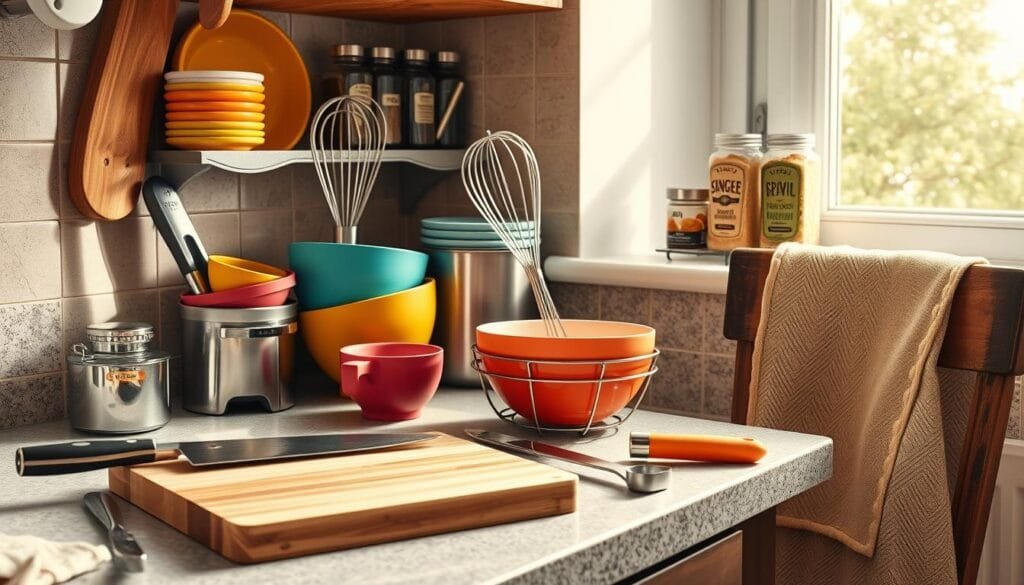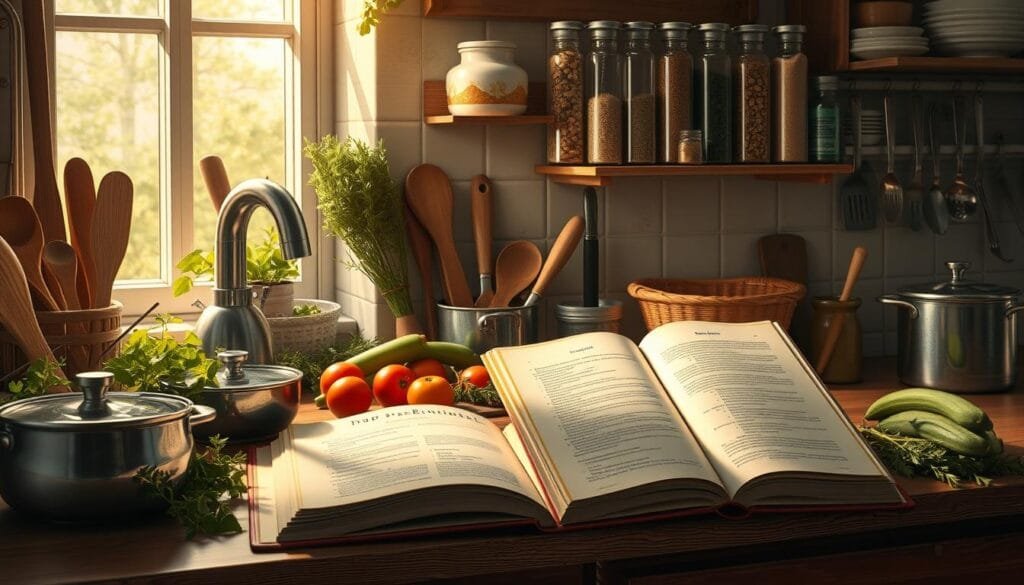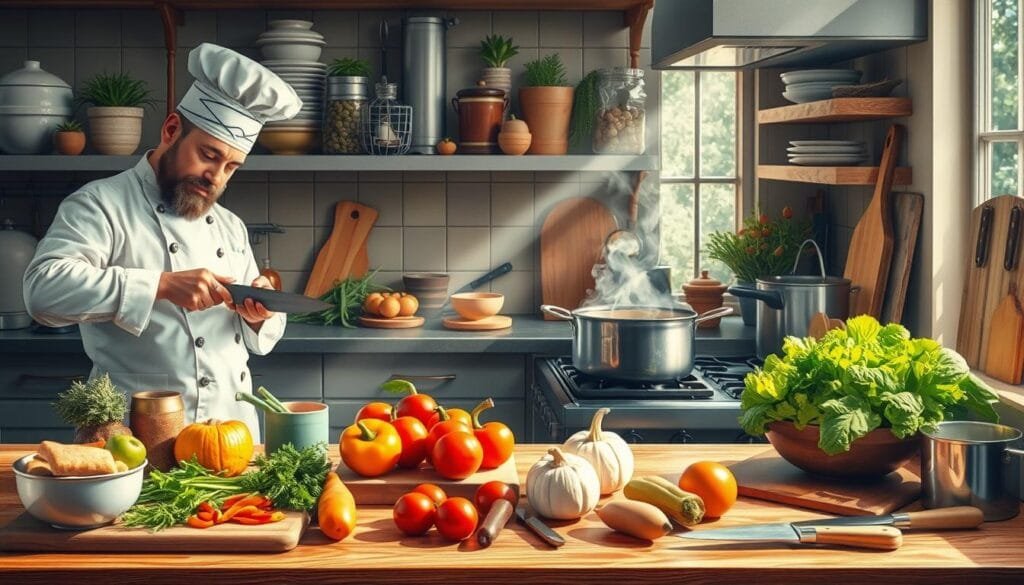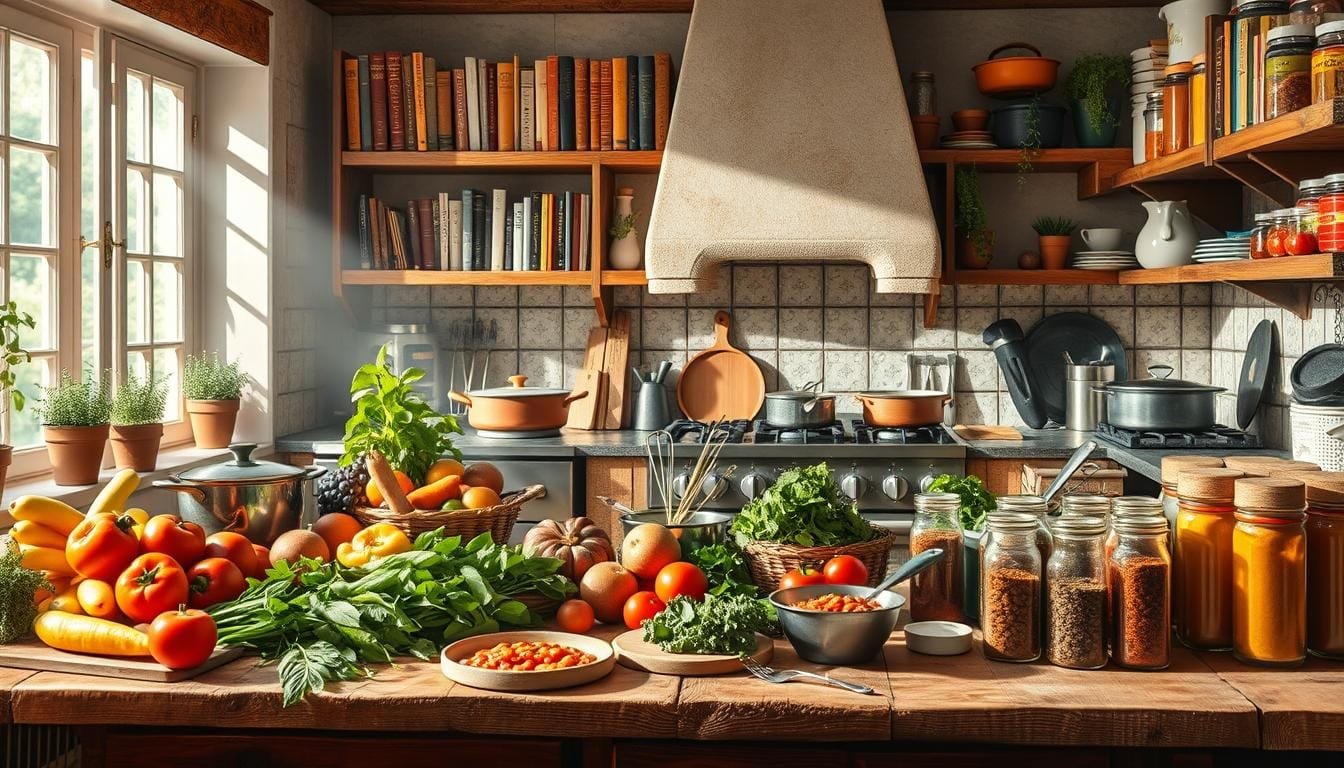Have you ever wondered what it takes to truly master home cooking? Today, we often choose quick food over nutritious, traditional meals. Learning the art of home economics cooking can change how we see our daily food.
Home economics is not outdated. It’s essential in our busy lives. Our guide covers everything from basic tools to advanced cooking methods. With this knowledge, you can make every meal a masterpiece and improve your skills in the kitchen.
This guide shows the value of good home cooking. It gives you the tools and techniques you need. Plus, it shares the many benefits of being skilled in the kitchen. This guide is perfect whether you’re new to home economics or want to get better at cooking.
Key Takeaways
- Understanding the core principles of home economics cooking
- The importance of acquiring essential kitchen skills
- Fundamental tools and equipment for a well-prepared kitchen
- Basic and advanced cooking techniques for everyday meals
- The long-term benefits of mastering home economics cooking
Introduction to Home Economics Cooking
Home economics cooking combines the art and science of household management with culinary skills. It teaches us about creating nutritious meals, managing budgets, and living independently. This subject offers many benefits and is important in our everyday lives.
What is Home Economics Cooking?
Home economics, or family and consumer sciences, includes many household and cooking skills. It became more accessible after the Vocational Education Act of 1963. The subject covers nutrition, food service, child care, and fashion design. Boys and girls in places like Finland have been learning it for over 100 years.
The Importance of Home Economics in Daily Life
Cooking at home is a key part of home economics. It lets people manage their nutrition and diets better. Nutritionists work with public agencies or food companies to help everyone eat healthier. Jobs like housekeepers, food service managers, and interior designers show how vital home economics is. Finland even includes it in their schools to help with sustainable development.
The Benefits of Mastering Home Economics Cooking
Being good at home economics cooking has lots of perks. It can lead to better health and saving money. Dietitians with home economics degrees show the health benefits. Food service managers and interior designers also benefit from these skills. Home economics can lead to jobs in research, teaching, or services. Learning home economics helps us improve our lives and succeed in our careers.
Essential Kitchen Tools and Equipment
Creating a functional kitchen starts with the right kitchen essentials. Knowing which cooking utensils and home kitchen appliances you need will change how you cook.
Must-Have Cooking Utensils
Your kitchen needs a variety of cooking utensils. A stainless steel chef’s knife is key for its longevity and resistance to rust. We also suggest getting:
- Wooden spoons
- Rubber spatula
- Flat spatula
- Tongs
- Whisk
Measuring tools are essential for safety in the kitchen. This means having dry measuring cups, measuring spoons, and a liquid measuring cup. These tools ensure precision and adherence to recipes, especially since many rely on volume.
Basic Appliances Every Kitchen Needs
For home kitchen appliances, a few basics can greatly enhance your cooking. Starting with the essentials:
- One 9-10” frying pan
- One 2-4 quart saucepan
- One 6-10 quart stock pot
It’s also crucial to have mixing bowls with lids, two baking sheets of different sizes, and an instant-read thermometer. These help ensure meats and casseroles are cooked safely.

Specialized Tools for Advanced Cooking
For advanced cooking, specialized tools are key. High-sided roasting tins capture juices during roasting. Multiple chopping boards prevent cross-contamination of foods like meats and veggies.
A knife sharpening or honing rod keeps knives sharp. For baking, kitchen scales ensure accuracy for ingredient preparation.
Kitchen shears are also crucial, offering versatility in food preparation beyond just cutting.
In conclusion, quality tools and appliances make cooking seamless. Avoid cheap utensils that might need frequent replacing. User reviews can help find durable, quality equipment.
is home economics cooking
When *defining home economics cooking*, it’s key to note its vast history and role. It began in the 1880s to teach women domestic skills and higher education access. Catherine Beecher and Ellen Swallow Richards, pioneers, started the American Association of Family and Consumer Sciences in the early 1900s.
Now, *home economics cooking* is more than making meals. It covers nutrition, budgeting, sustainability, and managing a family. Classes taught cooking, nutrition, child care, education, home upkeep, sewing, and how to manage money. Today, over 60% of these program students are male, showing it’s for everyone.

There’s been almost a 40% drop in home economics students recently, says the Association of Family and Consumer Sciences. Yet, it’s still important. Around 80% of high school programs include it, focusing on cooking, money management, and food safety. Child development is now a major focus, showing the field’s depth.
Home economics now includes important areas like child care, house upkeep, and budgeting. It’s valuable for both men and women in many jobs like design, fashion, and finance.
Skills like sewing are still crucial. Graduates enter fields like fashion design and merchandising, which are growing. Also, the average pay for an interior designer is $56,000 a year, showing good job prospects for those skilled in home management.
| Key Areas | Relevant Data |
|---|---|
| Financial Literacy | Cost of financial illiteracy: $1,389 per American in 2021 |
| Enrollment Trends | Decline by 40% in the last decade |
| Inclusive Education | 80% of programs now inclusive |
| Graduation Rate | 84% for 18 Reasons’ Program |
Groups like 18 Reasons boost food literacy outside of school. They serve 4,000 people yearly, including 600 kids, through community partnerships. Their program, Cooking Matters, handed out 24,000 pounds of groceries, teaching vital shopping and money skills.
In places like Kolkata, sewing is a key school subject. In the U.S., financial education is being enhanced. *Home economics cooking* teaches vital life management techniques. The average U.S. family spends a lot on eating out, showing the need for the skills taught in home economics.
To wrap up, defining *home economics cooking* means seeing its rich past, significance today, and broad appeal. This diverse field gives people key skills for life and work, making it an essential part of education.
Basic Cooking Techniques and Skills
Learning basic cooking techniques is key to becoming a good home chef. Skills like proper knife handling and cooking methods improve our meals. They let us cook delicious food with confidence.
Knife Skills: Chopping, Slicing, Dicing
Good knife skills are the start of great cooking. Chopping, slicing, and dicing the right way cooks food evenly. It also makes dishes look better. With the right knife techniques, cooking becomes easier and more fun.

The Art of Sautéing, Roasting, and Grilling
Each cooking method makes food taste different. Sautéing cooks food fast in a little fat, great for veggies and meat chunks. Roasting uses slow, dry heat to bring out sweet flavors. And grilling gives a smoky taste that adds a new flavor layer. By learning these methods, we can play with ingredients and styles, making our cooking better.
“Cooking from scratch using fresh ingredients can save families money and promote healthier eating habits. Furthermore, meal prepping once a week can help save time for families, creating smoother mealtime experiences.”
Understanding Flavor Profiles and Seasoning
Mixing spices and herbs right makes dishes balanced. Knowing flavor basics lets us enhance natural tastes. Seasoning well can turn a simple meal into something special. For tips on flavors, check this guide.
| Cooking Technique | Description | Best For |
|---|---|---|
| Sautéing | Cooking quickly in a small amount of fat over high heat | Vegetables, small meat pieces |
| Roasting | Slow cooking with dry heat | Vegetables, large cuts of meat |
| Grilling | Cooking over direct heat, often with a smoky flavor | Meats, vegetables |
Using these techniques and understanding flavoring makes our cooking diverse and tasty. We can cook with more confidence and creativity.
Conclusion
Mastering cooking skills is good for both our wallets and our health. Cooking at home saves money and reduces waste. The data on home economics cooking shows health benefits and time savings too.
Home cooking helps the planet as well. It cuts down on food waste and encourages the use of sustainable ingredients. This supports a healthier future. It also helps educators teach students about environmental responsibility.
Cooking at home brings more than food benefits. It enriches our skills, our relationships, and our understanding of where food comes from. Learning and trying new things in the kitchen helps us enjoy cooking. It also leads to a healthier, more sustainable, and financially sound life. So, keep up the cooking passion. Every meal you make is a step towards better cooking skills and the many benefits they bring.
FAQ
What is Home Economics Cooking?
Home economics cooking combines household management with cooking skills. It teaches nutritious meal preparation, budgeting, and kitchen organization. This fosters a health-driven, self-sufficient lifestyle.
Why is Home Economics important in daily life?
Home economics is key for everyday living. It teaches meal planning, cooking, and budgeting. These skills foster wellness, healthy families, and financial stability.
What are the benefits of mastering Home Economics Cooking?
Mastering it lets you make nutritious, wallet-friendly meals. You’ll boost your cooking skills, cut down on food waste, and get healthier. It also boosts self-reliance and smart decisions about food and home.
What are the must-have cooking utensils for a functional kitchen?
Essential utensils include knives, cutting boards, and measuring tools. Also needed are mixing bowls and various pans, like frying pans and saucepans. These basics aid in cooking and prep.
What basic appliances does every kitchen need?
Important kitchen appliances include a stove, oven, and fridge. Also essential are a blender and microwave. They assist in many cooking tasks, making food prep easier.
Are there specialized tools for advanced cooking?
Yes, advanced tools like pressure cookers and sous vide machines exist. Food processors and stand mixers also add to your kitchen. They refine cooking techniques and widen meal options.
What fundamental knife skills should every home chef know?
Every home chef must know basic knife skills. This includes chopping, slicing, and dicing. Good skills make kitchen work quicker and safer.
How do sautéing, roasting, and grilling differ in cooking?
Sautéing cooks food fast in a little oil over high heat. Roasting uses dry oven heat to cook evenly. Grilling cooks with direct heat from below, adding a unique flavor. Each method changes the food’s taste and texture.
How can I create perfect flavor profiles and seasoning for dishes?
To create perfect flavors, understand how tastes like salty, sweet, and umami mix. Using different spices and adjusting seasonings helps. It lets you fine-tune dish flavors to your liking.
